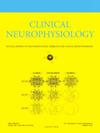基于深度学习的脑电源成像在不同电极配置下具有鲁棒性
IF 3.7
3区 医学
Q1 CLINICAL NEUROLOGY
引用次数: 0
摘要
目的以往的研究强调了高密度脑电图对常规脑电图源成像(ESI)结果准确可靠的必要性,限制了其在临床环境中只有低密度脑电图的应用。近年来,基于深度学习的ESI方法通过直接从数据中学习大脑时空活动模式,显示出了强大的性能。方法研究脑电电极数对新提出的基于深度学习的源成像框架(DeepSIF)的影响。通过计算机模拟和临床数据分析,我们评估了ESI在不同通道配置(16、21、32、64和75通道)下的性能,并将DeepSIF和传统方法与模拟的地面真实值和临床参考区域进行了比较。我们的研究结果表明,DeepSIF在不同信道计数和噪声水平下始终提供准确的源定位和程度估计,优于传统方法。在27例耐药癫痫患者队列中,当使用75/16个电极时,DeepSIF、sLORETA和LCMV的平均空间分散度分别为7.9/9.0 mm、21.9/28.1 mm和20.0/28.9 mm。结论DeepSIF算法对低密度脑电源成像具有鲁棒性。我们的研究结果表明,在不需要高密度脑电图设备的情况下,基于深度学习的源成像在临床环境中的广泛应用。本文章由计算机程序翻译,如有差异,请以英文原文为准。
Deep learning-based EEG source imaging is robust under varying electrode configurations
Objectives
Previous research has underscored the necessity of high-density EEG for accurate and reliable EEG source imaging (ESI) results with conventional ESI methods, limiting their utility in clinical settings with only low-density EEG available. In recent years, deep learning-based ESI methods have exhibited robust performance by directly learning spatiotemporal brain activity patterns from data.
Methods
This study investigates the impact of EEG electrode number on a newly proposed Deep Learning-based Source Imaging Framework (DeepSIF). Through computer simulations and clinical data analysis, we assess ESI performance across various channel configurations (16, 21, 32, 64, and 75 channels) comparing DeepSIF and conventional methods against the simulated ground truth and clinical reference regions.
Results
Our results indicate that DeepSIF consistently delivers accurate source localization and extent estimations across different channel counts and noise levels, surpassing conventional methods. In a cohort of 27 drug-resistant epilepsy patients, the average spatial dispersions for DeepSIF, sLORETA and LCMV are 7.9/9.0 mm, 21.9/28.1 mm, and 20.0/28.9 mm, respectively when using 75/16 electrodes.
Conclusions
Our results indicate the robust performance of DeepSIF algorithm for source imaging with low-density EEG.
Significance
Our findings suggest broad applications of the deep-learning based source imaging in clinical settings without the need for high-density EEG devices.
求助全文
通过发布文献求助,成功后即可免费获取论文全文。
去求助
来源期刊

Clinical Neurophysiology
医学-临床神经学
CiteScore
8.70
自引率
6.40%
发文量
932
审稿时长
59 days
期刊介绍:
As of January 1999, The journal Electroencephalography and Clinical Neurophysiology, and its two sections Electromyography and Motor Control and Evoked Potentials have amalgamated to become this journal - Clinical Neurophysiology.
Clinical Neurophysiology is the official journal of the International Federation of Clinical Neurophysiology, the Brazilian Society of Clinical Neurophysiology, the Czech Society of Clinical Neurophysiology, the Italian Clinical Neurophysiology Society and the International Society of Intraoperative Neurophysiology.The journal is dedicated to fostering research and disseminating information on all aspects of both normal and abnormal functioning of the nervous system. The key aim of the publication is to disseminate scholarly reports on the pathophysiology underlying diseases of the central and peripheral nervous system of human patients. Clinical trials that use neurophysiological measures to document change are encouraged, as are manuscripts reporting data on integrated neuroimaging of central nervous function including, but not limited to, functional MRI, MEG, EEG, PET and other neuroimaging modalities.
 求助内容:
求助内容: 应助结果提醒方式:
应助结果提醒方式:


